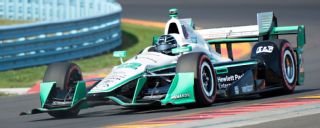|
The Verizon IndyCar Series' aero kit era is turning out to be more brief and less spectacular than hoped for. INDYCAR announced this week that development on aerodynamic components designed by Chevrolet and Honda will be frozen at the end of 2016 for the 2017 season. A single-spec body kit is under development for 2018 and beyond. INDYCAR introduced a 2.2-liter turbocharged engine formula in 2012 that attracted the participation of the two-engine manufacturers. Aero kits were added to the equation in 2015, but it turned out to be an expensive experiment that adversely affected the competitive balance between Honda and Chevrolet and created an additional hurdle for new manufacturers that might want to enter the sport. Since the introduction of aero kits, Chevrolet dominated the past two years, winning 24 of 32 races and sweeping the IndyCar driver and manufacturer championships. Honda's saving grace was Alex Rossi's fuel-strategy-driven victory in the 2016 Indianapolis 500. This past weekend at Sonoma Raceway, representatives from both engine manufacturers said they support both the aero development freeze for 2017 and the single-spec body for the extended future. "It was the attempt to show something new, something progressive with IndyCar," said Honda Performance Development president Art St. Cyr. "But it didn't attract the fans like we were hoping and we've spent a lot of money on that that we might have used to help build the series. We spent millions on the aero kits over the last couple of years, and I think this is a good move for the state we are in right now. "I said even when we went to aero kits that we really wanted to be in IndyCar for the engine," he added. "We're 'Honda Motor Company,' and that's HPD's primary focus on this. We're looking forward to what we can do once the aero side gets settled down." After winning just two of 15 races so far in 2016, Honda would appear to be at a disadvantage with the end-of-year spec frozen. But there are signs Honda could be closer to Chevrolet in 2017 despite being locked into this year's aero package. Honda cars were very competitive at most superspeedways, including the most important venue of all -- Indianapolis Motor Speedway. And Honda's lead team, Andretti Autosport, looked much better at Sonoma than it has at most road courses this year, with Rossi and Ryan Hunter-Reay finishing in the top five. Based on the current status quo, Chevrolet is naturally happy to continue with its 2016-spec aero parts in 2017. Chevrolet drivers Scott Dixon and Simon Pagenaud won the IndyCar Series championship the past two years, and the Bowtie brigade led Honda 14-2 in race wins this year. "I think the kits did what they were set out to do," remarked Mark Kent, director of racing for General Motors. "It was an opportunity to create some differentiation between the cars, and the second objective was to provide the manufacturers an opportunity to outwork, out-engineer and hopefully outperform their competition. I believe the Chevrolet kit did that, and I also believe that the aero kits have moved the series forward. "But as time rolls on, there's a new chapter in IndyCar, and we're supportive of the direction they're trying to go," Kent continued. "We've had great success with and without the aero kits, and -- as we look forward to '18, as IndyCar looks to move their series forward with their long-term vision of going back to a common kit -- we are supportive. "Hopefully it will make the sport interesting not only for new fans but also for new engine manufacturers." Although the 2017 aero freeze is somewhat of a compromise, INDYCAR has the opportunity to make major changes to its cars for 2018, in terms of the way they look and in terms of the way they perform. The common-spec 2018 car will use the Dallara IR-12 tub, gearbox and suspension components, but almost everything else from the floor on up will be substantially changed. The made-over "Indy car of tomorrow" is expected to adopt styling cues from the past while incorporating modern safety advances, moves that should help the IndyCar Series build on the momentum it has generated over the past couple of years. "I wish it was 2018 now!" laughed Andretti Autosport owner (and Honda entrant) Michael Andretti. "I wish we could have the Honda kit a little bit closer on the road courses; that's something we're going to have to deal with next year, but I'm really looking forward to '18. Things are really going in a positive direction. They are doing everything for good reason and trying to entice another manufacturer. "I think Jay Frye [INDYCAR president of competition and operations] has done a really good job," Andretti added. "Jay has really brought organization to INDYCAR in the area it was lacking. They're not making knee-jerk reactions; they're thinking things out with long-term plans -- things you really need to do to make your company successful."
|

